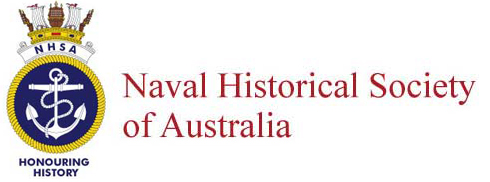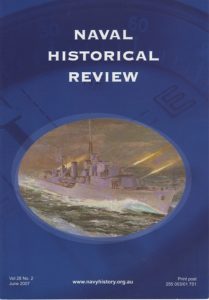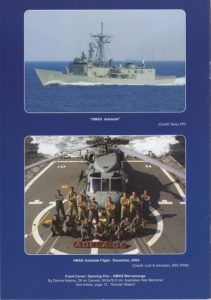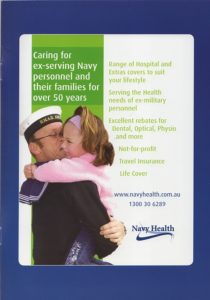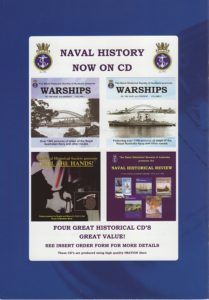- Author
- A.N. Other
- Subjects
- Biographies and personal histories, WWII operations, History - WW2
- Tags
-
- RAN Ships
- None noted.
- Publication
- September 2024 edition of the Naval Historical Review (all rights reserved)
Dr. Richmond Jeremy OBE MB ChM FRCP FRACP 1899 – 1995
Parts I and II of this series are contained in the March and June 2024 editions of this magazine. Part III concludes this narrative, taken from the memoirs of Dr Jeremy.
Homeward Bound via Crete, Egypt and Palestine (but some remained)
The Greek campaign was short and harrowing with the first Australian hospital staff being ordered to evacuate in the Hospital Ship Aba on 20 April 1941 and proceed to Alexandria. The following day more hospital staff were ferried to the troop transport Ulster Prince but she was bombed, ran aground and sank. Her evacuees were transferred to the cruiser HMS Phoebe and the destroyer HMAS Voyager which took them to Suda Bay in Crete. Richmond Jeremy made the voyage in Phoebe.
Other ships involved in this overall evacuation included the Dutch troopship Siamat and the destroyers HM Ships Diamond and Wryneck. All three ships were bombed and sunk with the loss of over 1000 lives.
Some however did not leave Greece as seven officers and 150 other ranks from the 2/5th AGH remained at the Ekali Hospital outside Piraeus where they treated Allied servicemen who were too ill or injured to be evacuated. These staff and their patients became POWs and Colonel William Kay, the Commanding Officer of the 2/5th AGH, died of wounds here. Later Allied casualties from Crete were flown in by German aircraft and treated here.
So we arrived on Crete on 25 April 1941, not as a functioning unit, but as a group to be fed from the short rations available, so that it could not be said that the unit served on Crete in the strict army sense. Our Africa Stars were won in Greece, I understand they were not given to us until Stuart Marshall made a fuss.
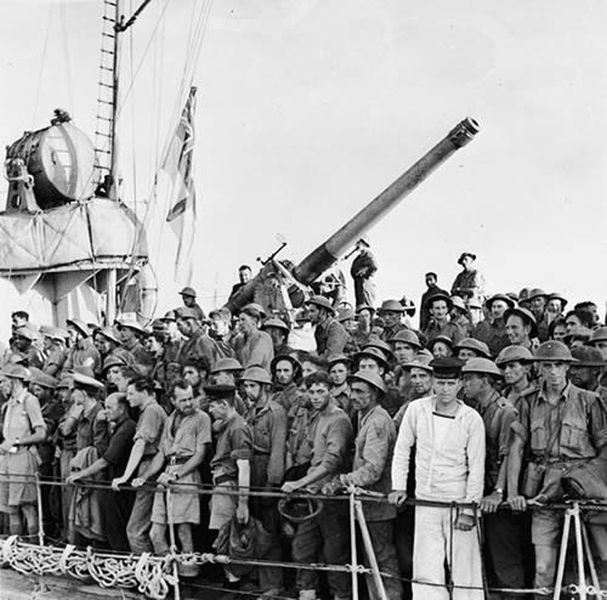
We were told that we were to go to camp C3 a ‘few miles’ east of Suda Bay and to proceed along the road, the only one, in that direction. I set off with de Burgh; leaving the road from the wharf we turned inland past a Hurricane plane on chocks, its large engine uncovered, evidently awaiting transport to Egypt for repairs. At a trestle table some women were serving tea and biscuits, they may have been the wives from the Welsh battalion that had been on Crete for a few months. After having tea we turned right up the road, the occasional soldiers that we met all said ‘it is just along the road a bit’. We walked until dusk, getting tired and presumably looking it, when two British officers offered to drive us to the camp. We settled in an olive grove, Laurie MacDonald had dug himself a slit trench complete with shelves and pronounced it ‘comfortable’ but we just lay on the ground.
We must have been near Maleme as we could hear the roar of Hurricane planes, and we all shared blankets. One of the captains had ‘crabs’, a venereal infection Pediculosis pubis, this was in accordance with his reputation. I wonder if he caught it from Marguerite in Volos. His mates isolated him and put up a notice.
There was a demijohn of rum and we enjoyed a dash of this in our tea in the mornings. We were able to bathe in quite a large nearby swiftly running creek. We had no Signals so the officers took turns in visiting a nearby South Australian machine-gun company. This was enjoyed, first it was good for us to sense the obvious high morale of this combatant unit, secondly a hospitable medical officer gave us whiskey. It was known, probably through the breaking of the German code by the ‘Ultra’ machine, that there was to be an invasion of Crete. The machine-gunners were not sure if they would be taking part as they had no ammunition!
The Cretan owner of the olive grove came to see us, being concerned about damage to his trees by digging. We left after a few days. Rex Money asked me to lead the hospital company, the administrative group led by Norman Sherwood preceded us. It seemed an easy march, we saw the masts of the radio station on our way down. Not far from our destination Sherwood halted his company on the open road: we marched past to get under the cover of trees, this seemed safer to me with enemy planes about. Sherwood protested, he was fond of drill but Rex Money made no comment.
We moved into a bivouac area (T Camp) at 42nd Street which was a long olive grove alongside the road running back to the spine of mountains behind the coastal plain, it was about a mile from the Suda Bay wharves. The area was very dusty and there were no latrines or ablution blocks. From our area we could see the western arm of Suda Bay; grounded there was the cruiser York which had been sunk by an Italian midget submarine. It was used as an anti-aircraft gun platform, there were many other ships nearby. We watched the raids from under our trees. When raids started, prepared oil fires were lit to suggest they had already been hit; photographs taken at the time show columns of smoke rising from the ships. I don’t know if this was an effective deception, as time went on the raids became more frequent.
During night raids we could see tracer shells of the Bofors going up and curving down at 7000 feet or so, the bombers kept above this. There were also 3.7 inch guns firing higher, no planes were hit by gunfire but one of our two Hurricane fighters from Maleme shot down a bomber, black smoke streaming as it crashed onto the Acrotiri Peninsular. In the hush following the raid we could hear a Vickers gun going, we were told that they were shooting at the pilot, a blonde German airman who went back to Egypt with us. At night a single plane was kept flying over dropping a bomb here and there, harassing fire such as the artillery use. After one such night, talking to de Burgh and Marshall, I said that we had had a poor sort of night; de Burgh said that he had seen 30,000 men killed before breakfast (on the Somme in France) and Marshall said ‘you should try walking across a paddock with machine guns popping at you’. I felt rebuked by these veterans. Marshall had been in France at the age of 15, it made him tough and cynical, but he was a tender-hearted man. de Burgh had been with the Argyll and Sutherland Highlanders and had been shot through the face when on patrol.
We had been told that lights at night would be fired on, but on a night drizzling with rain, when no planes could have possibly been over, I lit a cigarette under my blanket, at once a machine pistol fired over me into our tree ‘put out that bloody light’. I had no idea that we were so carefully watched over. Towards the end of our stay the troops fired their rifles until late at night, they were said to have been cleaning them. We could hear the whine of the bullets, there seemed to be a lot of troops about.
One day I walked to Canea for a haircut, it had been bombed, but little salvage was evident. I walked around the small harbour and looked into a cafe, it was full of Greek Air Force officers so I left. An English lieutenant offered me a ride back to Suda. He said he had been attacked by a plane and he was surprised at how far the bullets were spaced as they hit the road.
Rations became very short, very little bread, tinned sausages, beans with pork and just beans. We removed the lids from the cans and heated the food over twig fires as we did with our shaving water. One day on a walk de Burgh and I came across a large pile of loaves and a large pile of clothing. We asked the officer who seemed to be in charge if we could have a loaf of bread, he refused us but allowed us to take a shirt each.
I walked with Charles Lawes into the hills to try to find a stream to bathe in. We found one coming out of a rock and we were soaping ourselves when a group of girls appeared, calling out. We were bathing in their village water supply. One day Stuart Marshall and I found a large eucalyptus. Otto Nothling was warming his piles on the rock wall surrounding it. On our way back a fighter plane passed close over us, we hastened to get under the trees. Even though it was unlikely he would bother us he might have become playful.
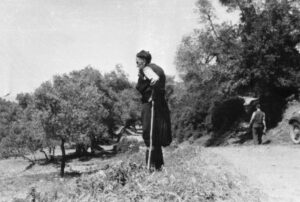
Captain Livingstone, an English medical officer, joined us, he had seen Bill Kay after he had been bombed at Piraeus and hopelessly wounded. Livingstone said that when in action and stressed it was best to give yourself a dose of morphine, it made you feel good and did not impair your competence as alcohol or barbiturates would. One night during the raid, I went to see him in his slit trench, he had a bottle of gin with him and was cursing and blasting the Germans, of course he had no work to do. Liquor was scarce, he probably got it from the English 7th Hospital near Canea.
Cretan boys sold us oranges, there were plenty of them so there was no scurvy. Before Suda our hygiene had been bad, we had been using the bushes; Charles Lawes and I were asked to attend to it. The method of the long trench a foot wide and a foot deep was used with the earth placed alongside it and turned in after use, a very effective method, but embarrassing to use in full view as we had no shelter. Later the officers were given a ‘thunder box’, de Burgh reported the CO for squatting over it – ‘what do you mean by kangarooing it?’ The CO may have been thinking of the officer with crabs. Stuart Marshall gave an intravenous pentothal for the removal of an abscessed tooth.
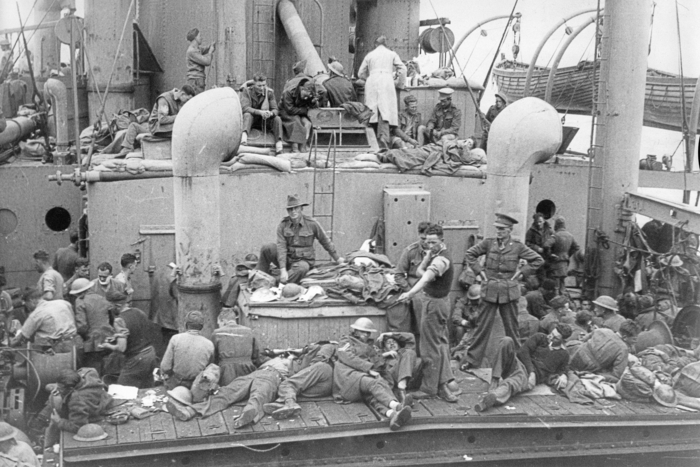
We knew that the battle for Crete must soon start and we wondered if we could get away. Lt-Colonel Leslie Le Souef, with a West Australian field ambulance, called on us, he was to stay. He later wrote a book about his experiences as a prisoner of war, To War Without a Gun. His previous work with the Militia in peacetime was invaluable. The course in hygiene and sanitation that Charles Lawes and I took at the Showground before we left Sydney also proved useful.
Nurses started returning from Crete to Egypt on 29 April 1941 aboard the Greek ship SS Ionia, reaching Gaza Ridge on 6 May 1941. The last medical units to be embarked at Suda Bay were the greater part of the 2/5th AGH, the 2/6th AGH and the 2/3rd CCS. These all left on 14th May, Lossiebank taking the 2/5th AGH and 2/3rd CCS, and Nieuw Zeeland the 2/6th AGH, 2/1st Field Hygiene Section and the 2/1st MAC. Lossiebank was carrying nearly 2000 men and caused some anxiety when one engine broke down; she was forced to circle for two hours in the danger area until the defect had been remedied. Both ships were attacked from the air, and had some narrow escapes, but arrived at Alexandria safely and then the medical staff travelled by train back to Gaza Ridge in Palestine.
The day finally came, we fell in for a roll call and marched down the causeway to the wharf. On the way some planes came over and we scattered; when I came back on to the road I chanced upon the CO. He said that I was not going to lead the unit which surprised me. Near the ship more planes went over, we started to scatter but Rex called us together telling us not to miss our chance of getting away. We boarded the 15,000-ton Nieuw Zeeland; the Lossiebank on the opposite side of the wharf, the 2/3rd CCS was on board her with Bruce Hall. We left about dusk, I stayed on deck watching the propellers stirring up mud, there were tea and sandwiches in the lounge. Our ship was crowded with troops and civilians, there was no allocation of boats. There were notices on the stairways etc, put there by marines when they came to Suda indicating directions for an emergency. Had we seriously been attacked there could only have been confusion, probably panic.
The CO sent Laurie MacDonald into a hold, Laurie wondered what he could do there. In the lounge a New Zealand captain played the piano for popular songs which were sung loudly. The blonde German airman, in the charge of an English officer, looked on, he probably thought us too stupid to realise our position.
We were escorted by three destroyers, two RN and one Greek. The Navy tried to beat off air attacks but their main function was to take off personnel from unserviceable ships, then to sink them. We saw no more planes on our way back to Egypt, even when going around the eastern end of Crete, an area which was known as ‘Bomb Alley’. This must have been a fortune of war, probably the Germans were organising the aerial assault on Crete. We passed through the Mediterranean Fleet, or a large part of it, there were many small warships guarding the Queen Elizabeth and Barham. We disembarked at Port Said, the German airman prisoner was taken off in a launch.
Return to Egypt
We went by train to Kantara on the banks of the Suez Canal where we were given tea and biscuits again in a marquee. I sat alongside the table with de Burgh, opposite were Rex Money and George Halliday, to their right sat an English captain looking shaken and depressed, he was smoking cigarettes. Rex Money said ‘things would have gone better in Greece if people had not smoked’. This extraordinary claim was positively supported by Halliday.
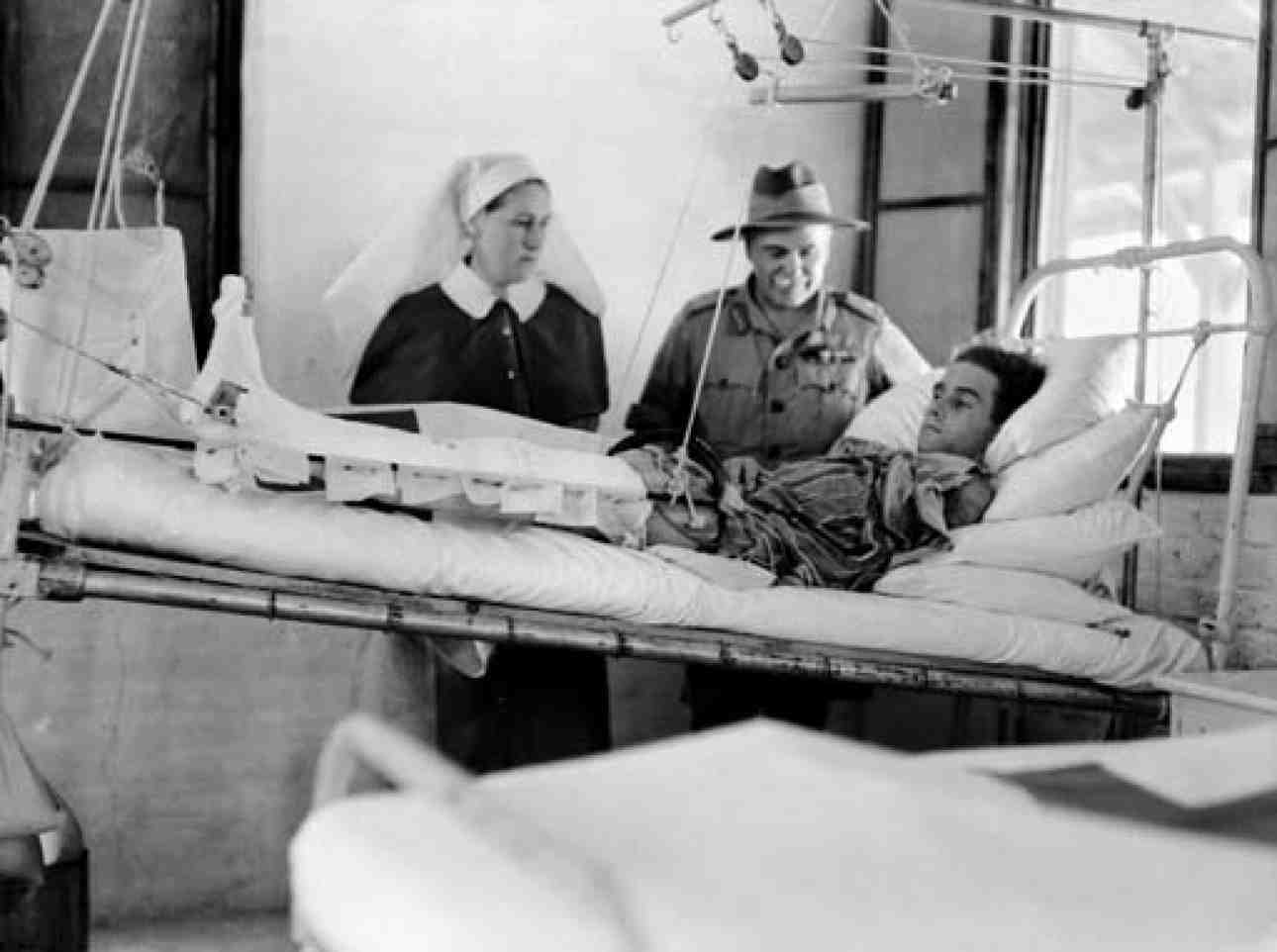
This annoyed de Burgh who called Halliday a ‘sycophantic bum sucking bastard’; there was nearly a fight, I had to stand between them. Some reinforcements were complaining of the unpleasant conditions on the Queen Mary, our men were scornful of them.
The 2/6th AGH then established itself at Kilo 89 along with the 2/3rd AGH, the 2/5th AGH and the 2/3 Casualty Clearing Station, remaining there from May 1941 until February 1942. Next stop was Jerusalem where they utilised the ‘Kaisers Palace’ on Mont Scopus before returning to Gaza Ridge from March 1942 until 16 January 1943. Managing 1200 beds while there, they despatched a surgical team to the Western Desert from October until 27 November 1942. Then on 1 January 1943 the hospital’s personnel boarded HMT Queen of Bermuda for Fremantle where they arrived on 12 February 1943. On 19 February 1943 they boarded the Queen Mary in Fremantle for Sydney.
Someone said ‘we’ll go if PR will play’ (Palestinian Railways). Evidently they did as we entrained and got off at Kilo 89. We were given a glass of cold beer in the mess there. That night we slept soundly on a cement floor in a hut, then next in a tent on the sand. The Arabs had stolen the tent sides so we were almost in the open again. I went across to see Lorimer Dods at the First Hospital which was next door. He said that I was now about the right weight but my finger nails were dirty, he lent me a nail brush.
Kantara and Cairo
We received mail from home which had been kept back for us. Some asked for leave to Cairo and got it and we were told that the unit was to be disbanded, this was upsetting but of course inevitable with all our equipment gone. I was told I would be doing Medical Boards in Palestine, I think it was to be Deir Suneid. I did not like the idea of this, perhaps I would be sending young men back into a similar balls-up as was Greece and Crete.
We went to a leave boat, a houseboat on the Nile. de Burgh and I arrived there late at night to be met, somewhat rudely, by the officer in charge, who was a gynecologist. Major de Burgh was good at dealing with people like that and reduced him to size.
I was told later that an army order came out, ‘It shall be an offence to throw Major (…) into the Nile’. Evidently this man was too much for the younger officers! Charles Lawes, C.G. McDonald and Fred Niesche were there too. The cabins were intolerably hot in the daytime.
de Burgh and I went to see the Alabaster Mosque, the guide told us about his five daughters needing his support, heartlessly we gave him nothing. We made the standard trip to the pyramids and rode on the tired camels to the Sphinx. Richardson gave my camel a belt and nearly unseated me. We went one night to a large hall, packed with men, to see a belly-dancer perform. She may have been an expert, I had no standards to make a judgement. Charles Lawes took me one night to meet Mrs Allen, the wife of Brigadier ‘Tubby’ Allen. Some of the wives of senior officers were allowed, at that time, to come to Egypt.
One night some of the local girls came to dance with us on the ship. I met Copt girls, one of them said that Fred Niesche resembled Conrad Veight the movie star, and he did. I went to a stationer’s shop to buy melanyl marking ink. The man who served me said ‘You must be a doctor, you are so polite’.
I am sure that he must have met those unbelievably patronising young English officers with their suede desert shoes. A tailor made for me a very well-fitting summer uniform for £10.
One evening we visited the New Zealand Hospital at Heliopolis. As a measure of safety they had sunk the floors of their tented wards about three feet below ground level. It seemed unlikely that Cairo would be attacked. There was no black-out, rather a brown-out such as prevailed in Sydney later on. I played a round of golf at the Ghezireh club with Eric Hughes-Jones and later swam in the very crowded swimming pool there. This later proved to be unwise when I got a viral infection probably acquired there. I had some right groin pain which I had thought might have been renal in origin. Eric Hughes-Jones told me that if I had to be investigated that the best man for this would be a surgeon at the 2nd Hospital at Kantara.
I was having lunch later, in Cairo, with John Halliday and Sister Breakell whom I had known at the Clarmore Private Hospital in Sydney; she was a member of the English Army Medical Service. I told them that I felt depressed and ill. John gave me a note to Major-General Burston, I saw him the next day at Shepheard’s Hotel, he told me that I could go into any hospital I chose. I selected the 2nd Hospital at Kantara because of Eric Hughes-Jones’ recommendation. I also knew that the area of Kantara was regularly bombed as it was on the canal at an important junction.
Taking my-rail warrant to the Railway Transport Office on Cairo station I met Sister Stevenson who was later Matron of St Luke’s Hospital in Sydney. Later I was in a carriage with a captain and two other men who were ‘other ranks’. The captain told me he was in the Dental Corps. The men started to eat their sandwiches, this upset the captain who upbraided them for eating in our august presence. He could have been correct but I said nothing. For some time, I had been eating in the presence of all ranks and enjoyed it, I kept quiet, but the men left the carriage. At one stage the train stopped for an air raid warning, the engine left us, so there was the usual delay until the scare was over and the driver thought it was safe to hook up again. On one aerodrome I saw a Vickers Vimy aircraft, the same as the plane I saw Ross and Keith Smith land at Mascot (Sydney) in 1918, evidently they were still in use.
After a few days in hospital the reason for my malaise became evident, I developed a fever with headache and general aches, with a very slow pulse. Then I got bilateral otitis media, this illness delayed the renal investigation; then the surgeon went away and Eric Hughes-Jones said he would do the cystoscopy, did I mind? Then I was told that I was to be Boarded, he said that it was an order and that was that. I finally had the renal investigation carried out by Eric Hughes-Jones, it was normal. The procedure of the Medical Board was unusual, at least to me. The soldier presented himself to the doctors, his case was gone into, then he was examined. I did not know that my Board was being done, I believe, by Britten Jones and the surgeon who had not examined me for a few weeks. I was classed as C, which meant return to Australia for a further Board in six months. I was surprised and disappointed as I had lost all my shyness at being in the army having, in a way, become a veteran in the space of a few months.
Under observation
I liked the people at the 2nd Hospital, by which I mean mainly the nurses. During air raids on the Suez Canal they would often come to talk to me. Perhaps they were observing my reactions, I know they were instructed to do that. I adopted de Burgh’s light-hearted approach; one night there was a huge explosion, probably from a mine which missed the canal and hit the sand, a nurse ran in ‘whatever was that?’, I said ‘I think my carbuncle has burst’. I had boils and a carbuncle, this happened after a restricted diet, followed by a full diet which raised the sugar content of the tissues making them more susceptible to infection. These recurring boils worried me after my return to Australia.
More about the 2/2nd AGH at Kantara
The Arabs, using the hospital water supply via a small hose, grew very healthy-looking sweet corn on what seemed to be sterile looking sand. In the heat of the day, say 116 degrees F, they would lie down to sleep in the nearest shade available.
An English Lieutenant from an anti-aircraft battery on the canal told me that Arabs were employed to watch the canal during air raids to see if and where the Germans laid mines from their planes. The planes were said to come from Rhodes and at Kantara there was a twenty minutes warning. When the sirens went, the Arabs then took off into the desert and were a safe twenty minutes away when the planes arrived.
This young English Lieutenant used to visit one of the sisters. One night when she thought he was getting too fresh she said ‘now then, be your age, be your age’. He said he was being his age, as he was twenty-two.
A young medical major from Melbourne showed me a German doctor’s parachutist’s pack brought back from Crete. There was a small insignificant Red Cross on it which could not possibly have been seen in battle, and he had been killed. Noticeable was that the medicines were in tablet form, except for some tincture of opium and a small pair of scissors made in Sheffield! His name was Steiffen. At that time, at least in the hospital our medicines were in bottles, carried in cumbersome panniers, but not designed to be dropped from aeroplanes. In the ward nearby was an Australian lieutenant; on Crete he came across a German parachutist laying out his camera and bathing costume, evidently preparing for a Cretan holiday. Both aimed their revolvers, he killed the German but sustained a nasty wound of his hand and wrist.
One of the sisters hired a horse and sulky and took me, with others, to a picnic on the canal bank. Some of us swam in the canal. While we were there a man came up to us and said that he would like to talk English with us. He was an Englishman who had been in Egypt for eighteen years and had got used to the life and did not think he would ever go back to England. He was an engineer helping to construct an oil pipeline from Suez to Port Said.
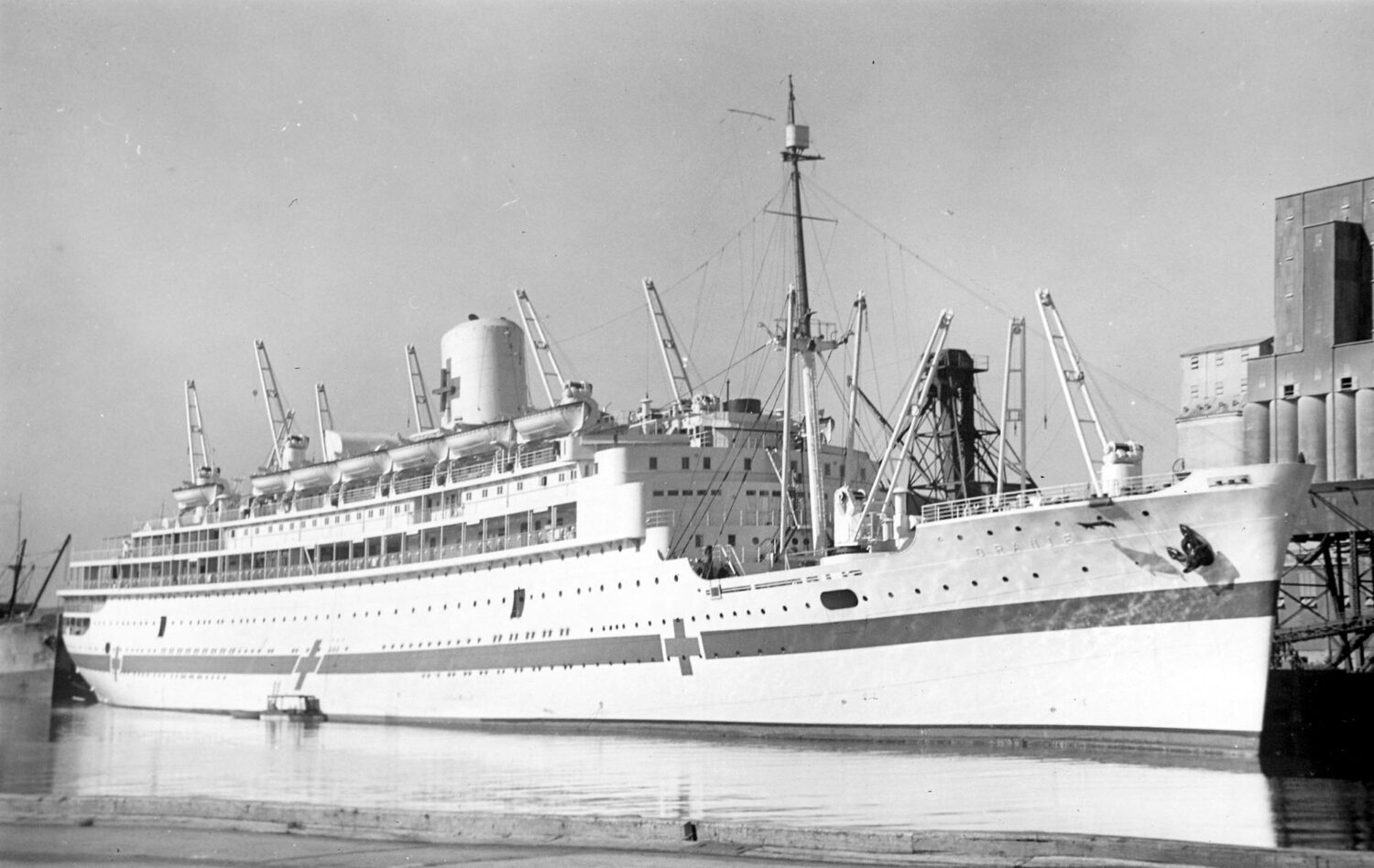
The return home
The cruiser HMS Orion transited the canal with the severe damage to her mast and guns quite obvious (the 2/6th AGH had originally been ferried in Orion from Alexandria to Piraeus on 7 March 1941). Over the flat sand of the desert, ships in the canal seemed to be ships of the desert.
I was told that a bomb had burst in the sick bay so, unless they had been transferred, my friends the naval doctor and his petty officer had been killed. Otto Nothling was in hospital, he was a bowler in first class cricket; he showed me how a ‘wrong-un’ was bowled. A Sydney surgeon, who was working in the hospital, used to bring me a double whiskey at night, from the mess, concealed in his tunic.
Laurie MacDonald also working in the hospital saw me off when I went on leave to Gaza. The train was packed with troops going up to Syria. While I was there I saw the casualties coming back from Syria, they were mostly suffering from malaria which they had met to an unexpected degree.
In early August 1941 some 640 invalided ANZAC troops from the Middle East were taken by train to Suez for embarkation. With German air raids every night the ship had to put to sea in the evenings to remain outside bomber range, this meant loading took three days when some patients were on the ship and others sent to a holding camp ashore.
Oranje departed on 8 August and made a fast passage of less than 12 days arriving first in Fremantle on 20 August, then proceeding via Adelaide, Melbourne, Sydney and finally Wellington where the last of her patients were all safely discharged in mid-September 1941.
Later life
After his return and reunion with his family, Dr Jeremy was later discharged from the Army medically unfit but after Japan entered the war he served again, although part-time, at the 113th AGH at Concord in Sydney. Dr Jeremy continued to practise as a consultant physician from Macquarie Street and was honorary physician at St Vincent’s Hospital and other Sydney hospitals. After a distinguished career he retired in 1969 when he was aged 70 and was appointed an Officer of the Order of the British Empire (OBE) for his services to medicine. Richmond Jeremy died in 1995 in his 96th year.
